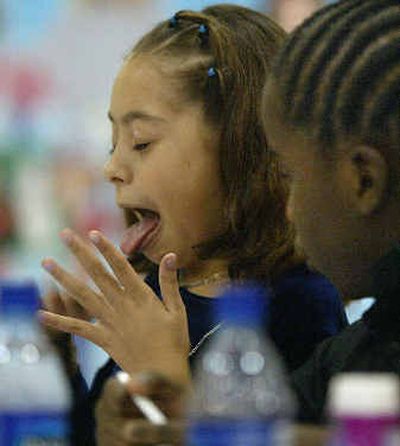Nutritionists take taste test to the experts

FORT WORTH, Texas – As she devours a sweet potato pancake at a taste test at her school, fourth-grader Paige Murset gives her seal of approval: “I like it. It’s really, really sweet.”
Next up was a “peanut butter and jelly sandwich” made with sunflower seeds instead of peanut butter.
Shante Brown sizes it up beautifully: “It was good, but it tastes like sunflower seeds.”
With their OK, such foods could make it into school cafeterias across the country.
They were among 40 fourth- and fifth-graders at Meadowbrook Elementary School on Wednesday testing food like blueberry burgers, dried plum barbecue sauce and asparagus salsa for a U.S. Department of Agriculture event celebrating National School Food Lunch week.
The USDA runs the National School Lunch Program and has often been under fire for not requiring healthier standards, particularly as the number of overweight children continues to grow.
“This is an opportunity to try out some brand new food products and see if kids like them,” said John Perkins of the Texas Department of Agriculture.
Eric Foreman, a fruit and vegetable program administrator for the USDA, said the agency hopes the results of the taste test inspire those who prepare meals for the kids to get creative in putting more fruits and vegetables into school lunches.
“We want to help introduce products that are higher in nutrition, lower in fat, to the kids,” said John Lund, head of USDA’s food quality assurance program.
The smoky-tasting blueberry burgers – a combination of ground beef and blueberry puree – for instance, have the advantage of being lower in fat and packed with blueberries’ antioxidants.
“It’ll be up to the students and the schools whether they’ll see these on their menus,” he said.
Lund said the kids’ opinions were vital. “They’re our ultimate customer. If they’re not going to eat it, it’s plate waste.”